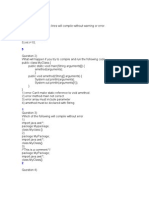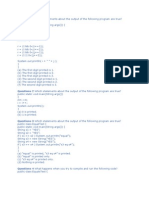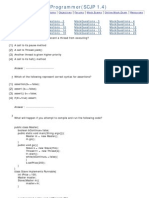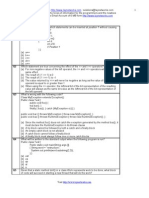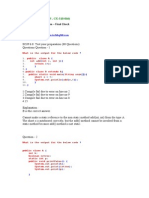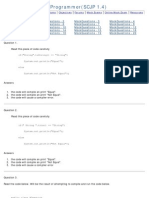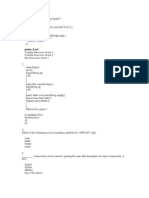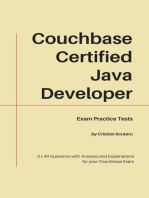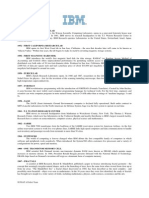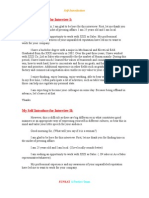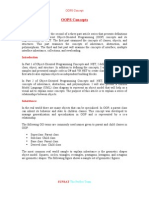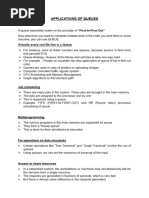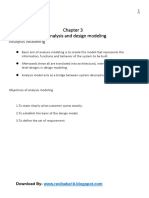Java Paper
Uploaded by
api-26403048Java Paper
Uploaded by
api-26403048Java Test
Java Test
Question 1:
What will happen when you attempt to compile and run this code?
abstract class Base{
abstract public void myfunc();
public void another(){
System.out.println("Another method");
}
}
public class Abs extends Base{
public static void main(String argv[]){
Abs a = new Abs();
a.amethod();
}
public void myfunc(){
System.out.println("My Func");
}
public void amethod(){
myfunc();
}
}
1) The code will compile and run, printing out the words "My Func"
2) The compiler will complain that the Base class has non abstract methods
3) The code will compile but complain at run time that the Base class has non abstract
methods
4) The compiler will complain that the method myfunc in the base class has no body,
nobody at all to looove it
Question 2:
What will happen when you attempt to compile and run this code?
public class MyMain{
public static void main(String argv){
System.out.println("Hello cruel world");
}
}
1) The compiler will complain that main is a reserved word and cannot be used for a class
2) The code will compile and when run will print out "Hello cruel world"
SUNSAT The Perfect Team
Java Test
3) The code will compile but will complain at run time that no constructor is defined
4) The code will compile but will complain at run time that main is not correctly defined
Question 3:
Which of the following are Java modifiers?
1) public
2) private
3) friendly
4) transient
5) vagrant
Question 4:
What will happen when you attempt to compile and run this code?
class Base{
abstract public void myfunc();
public void another(){
System.out.println("Another method");
}
}
public class Abs extends Base{
public static void main(String argv[]){
Abs a = new Abs();
a.amethod();
}
public void myfunc(){
System.out.println("My func");
}
public void amethod(){
myfunc();
}
}
1) The code will compile and run, printing out the words "My Func"
2) The compiler will complain that the Base class is not declared as abstract.
3) The code will compile but complain at run time that the Base class has non abstract
methods
4) The compiler will complain that the method myfunc in the base class has no body,
nobody at all to looove it
SUNSAT The Perfect Team
Java Test
Question 5:
Why might you define a method as native?
1) To get to access hardware that Java does not know about
2) To define a new data type such as an unsigned integer
3) To write optimised code for performance in a language such as C/C++
4) To overcome the limitation of the private scope of a method
Question 6:
What will happen when you attempt to compile and run this code?
class Base{
public final void amethod(){
System.out.println("amethod");
}
}
public class Fin extends Base{
public static void main(String argv[]){
Base b = new Base();
b.amethod();
}
}
1) Compile time error indicating that a class with any final methods must be declared
final itself
2) Compile time error indicating that you cannot inherit from a class with final methods
3) Run time error indicating that Base is not defined as final
4) Success in compilation and output of "amethod" at run time.
Question 7:
What will happen when you attempt to compile and run this code?
public class Mod{
public static void main(String argv[]){
}
public static native void amethod();
1) Error at compilation: native method cannot be static
2) Error at compilation native method must return value
3) Compilation but error at run time unless you have made code containing native
SUNSAT The Perfect Team
Java Test
amethod available
4) Compilation and execution without error
Question 8:
What will happen when you attempt to compile and run this code?
private class Base{}
public class Vis{
transient int iVal;
public static void main(String elephant[]){
}
}
1)Compile time error: Base cannot be private
2)Compile time error indicating that an integer cannot be transient
3)Compile time error transient not a data type
4)Compile time error malformed main method
Question 9:
What happens when you attempt to compile and run these two files in the same
directory?
//File P1.java
package MyPackage;
class P1{
void afancymethod(){
System.out.println("What a fancy method");
//File P2.java
public class P2 extends P1{
afancymethod();
SUNSAT The Perfect Team
Java Test
1) Both compile and P2 outputs "What a fancy method" when run
2) Neither will compile
3) Both compile but P2 has an error at run time
4) P1 compiles cleanly but P2 has an error at compile time
Question 10:
You want to find out the value of the last element of an array. You write the following
code. What will happen when you compile and run it.?
public class MyAr{
public static void main(String argv[]){
int[] i = new int[5];
System.out.println(i[5]);
}
}
1) An error at compile time
2) An error at run time
3) The value 0 will be output
4) The string "null" will be output
Question 11:
You want to loop through an array and stop when you come to the last element. Being a
good java programmer and forgetting everything you ever knew about C/C++ you know
that arrays contain information about their size. Which of the following can you use?
1)myarray.length();
2)myarray.length;
3)myarray.size
4)myarray.size();
Question 12:
What best describes the appearance of an application with the following code?
import java.awt.*;
public class FlowAp extends Frame{
public static void main(String argv[]){
FlowAp fa=new FlowAp();
fa.setSize(400,300);
fa.setVisible(true);
SUNSAT The Perfect Team
Java Test
FlowAp(){
add(new Button("One"));
add(new Button("Two"));
add(new Button("Three"));
add(new Button("Four"));
}//End of constructor
}//End of Application
1) A Frame with buttons marked One to Four placed on each edge.
2) A Frame with buutons marked One to four running from the top to bottom
3) A Frame with one large button marked Four in the Centre
4) An Error at run time indicating you have not set a LayoutManager
Question 13:
How do you indicate where a component will be positioned using Flowlayout?
1) North, South,East,West
2) Assign a row/column grid reference
3) Pass a X/Y percentage parameter to the add method
4) Do nothing, the FlowLayout will position the component
Question 14:
How do you change the current layout manager for a container
1) Use the setLayout method
2) Once created you cannot change the current layout manager of a component
3) Use the setLayoutManager method
4) Use the updateLayout method
Question 15:
Which of the following are fields of the GridBagConstraints class?
1) ipadx
2) fill
3) insets
4) width
Question 16:
What most closely matches the appearance when this code runs?
SUNSAT The Perfect Team
Java Test
import java.awt.*;
public class CompLay extends Frame{
public static void main(String argv[]){
CompLay cl = new CompLay();
}
CompLay(){
Panel p = new Panel();
p.setBackground(Color.pink);
p.add(new Button("One"));
p.add(new Button("Two"));
p.add(new Button("Three"));
add("South",p);
setLayout(new FlowLayout());
setSize(300,300);
setVisible(true);
}
}
1) The buttons will run from left to right along the bottom of the Frame
2) The buttons will run from left to right along the top of the frame
3) The buttons will not be displayed
4) Only button three will show occupying all of the frame
Question 17:
Which statements are correct about the anchor field?
1) It is a field of the GridBagLayout manager for controlling component placement
2) It is a field of the GridBagConstraints class for controlling component placement
3) A valid setting for the anchor field is GridBagConstraints.NORTH
4) The anchor field controls the height of components added to a container
Question 18:
What will happen when you attempt to compile and run the following code?
public class Bground extends Thread{
public static void main(String argv[]){
Bground b = new Bground();
b.run();
}
public void start(){
for (int i = 0; i <10; i++){
System.out.println("Value of i = " + i);
}
SUNSAT The Perfect Team
Java Test
}
}
1) A compile time error indicating that no run method is defined for the Thread class
2) A run time error indicating that no run method is defined for the Thread class
3) Clean compile and at run time the values 0 to 9 are printed out
4) Clean compile but no output at runtime
Question 19:
When using the GridBagLayout manager, each new component requires a new instance
of the GridBagConstraints class. Is this statement
1) true
2) false
Question 20:
Which most closely matches a description of a Java Map?
1) A vector of arrays for a 2D geographic representation
2) A class for containing unique array elements
3) A class for containing unique vector elements
4) An interface that ensures that implementing classes cannot contain duplicate keys
Question 21:
How does the set collection deal with duplicate elements?
1) An exception is thrown if you attempt to add an element with a duplicate value
2) The add method returns false if you attempt to add an element with a duplicate value
3) A set may contain elements that return duplicate values from a call to the equals
method
4) Duplicate values will cause an error at compile time
Question 22:
What can cause a thread to stop executing?
1) The program exits via a call to System.exit(0);
2) Another thread is given a higher priority
3) A call to the thread's stop method.
4) A call to the halt method of the Thread class
Question 23:
SUNSAT The Perfect Team
Java Test
For a class defined inside a method, what rule governs access to the variables of the
enclosing method?
1) The class can access any variable
2) The class can only access static variables
3) The class can only access transient variables
4) The class can only access final variables
Question 24:
Under what circumstances might you use the yield method of the Thread class
1) To call from the currently running thread to allow another thread of the same or higher
priority to run
2) To call on a waiting thread to allow it to run
3) To allow a thread of higher priority to run
4) To call from the currently running thread with a parameter designating which thread
should be allowed to run
Question 25:
What will happen when you attempt to compile and run the following code
public class Hope{
public static void main(String argv[]){
Hope h = new Hope();
}
protected Hope(){
for(int i =0; i <10; i ++){
System.out.println(i);
}
}
}
1) Compilation error: Constructors cannot be declared protected
2) Run time error: Constructors cannot be declared protected
3) Compilation and running with output 0 to 10
4) Compilation and running with output 0 to 9
Question 26:
What will happen when you attempt to compile and run the following code
public class MySwitch{
public static void main(String argv[]){
SUNSAT The Perfect Team
Java Test
MySwitch ms= new MySwitch();
ms.amethod();
}
public void amethod(){
int k=10;
switch(k){
default: //Put the default at the bottom, not here
System.out.println("This is the default output");
break;
case 10:
System.out.println("ten");
case 20:
System.out.println("twenty");
break;
}
}
}
1) None of these options
2) Compile time error target of switch must be an integral type
3) Compile and run with output "This is the default output"
4) Compile and run with output of the single line "ten"
Question 27:
Which of the following is the correct syntax for suggesting that the JVM performs
garbage collection
1) System.free();
2) System.setGarbageCollection();
3) System.out.gc();
4) System.gc();
Question 28:
What will happen when you attempt to compile and run the following code
public class As{
int i = 10;
int j;
char z= 1;
boolean b;
public static void main(String argv[]){
As a = new As();
SUNSAT The Perfect Team
Java Test
a.amethod();
}
public void amethod(){
System.out.println(j);
System.out.println(b);
}
}
1) Compilation succeeds and at run time an output of 0 and false
2) Compilation succeeds and at run time an output of 0 and true
3) Compile time error b is not initialised
4) Compile time error z must be assigned a char value
Question 29:
What will happen when you attempt to compile and run the following code with the
command line "hello there"
public class Arg{
String[] MyArg;
public static void main(String argv[]){
MyArg=argv;
}
public void amethod(){
System.out.println(argv[1]);
}
}
1) Compile time error
2) Compilation and output of "hello"
3) Compilation and output of "there"
4) None of the above
Question 30:
What will happen when you attempt to compile and run the following code
public class StrEq{
public static void main(String argv[]){
StrEq s = new StrEq();
}
private StrEq(){
String s = "Marcus";
String s2 = new String("Marcus");
if(s == s2){
SUNSAT The Perfect Team
Java Test
System.out.println("we have a match");
}else{
System.out.println("Not equal");
}
}
}
1) Compile time error caused by private constructor
2) Output of "we have a match"
3) Output of "Not equal"
4) Compile time error by attempting to compare strings using ==
Question 31:
What will happen when you attempt to compile and run the following code
import java.io.*;
class Base{
public static void amethod()throws FileNotFoundException{}
}
public class ExcepDemo extends Base{
public static void main(String argv[]){
ExcepDemo e = new ExcepDemo();
}
public static void amethod(){}
protected ExcepDemo(){
try{
DataInputStream din = new DataInputStream(System.in);
System.out.println("Pausing");
din.readChar();
System.out.println("Continuing");
this.amethod();
}catch(IOException ioe) {}
}
}
1)Compile time error caused by protected constructor
2) Compile time error caused by amethod not declaring Exception
3) Runtime error caused by amethod not declaring Exception
4) Compile and run with output of "Pausing" and "Continuing" after a key is hit
Question 32
SUNSAT The Perfect Team
Java Test
What will happen when you attempt to compile and run this program
public class Outer{
public String name = "Outer";
public static void main(String argv[]){
Inner i = new Inner();
i.showName();
}//End of main
private class Inner{
String name =new String("Inner");
void showName(){
System.out.println(name);
}
}//End of Inner class
}
1) Compile and run with output of "Outer"
2) Compile and run with output of "Inner"
3) Compile time error because Inner is declared as private
4) Compile time error because of the line creating the instance of Inner
Question 33:
What will happen when you attempt to compile and run this code
//Demonstration of event handling
import java.awt.event.*;
import java.awt.*;
public class MyWc extends Frame implements WindowListener{
public static void main(String argv[]){
MyWc mwc = new MyWc();
}
public void windowClosing(WindowEvent we){
System.exit(0);
}//End of windowClosing
public void MyWc(){
setSize(300,300);
setVisible(true);
}
}//End of class
1) Error at compile time
2) Visible Frame created that that can be closed
3) Compilation but no output at run time
4) Error at compile time because of comment before import statements
SUNSAT The Perfect Team
Java Test
Question 34:
Which option most fully describes will happen when you attempt to compile and run the
following code
public class MyAr{
public static void main(String argv[]) {
MyAr m = new MyAr();
m.amethod();
}
public void amethod(){
static int i;
System.out.println(i);
}
}
1) Compilation and output of the value 0
2) Compile time error because i has not been initialized
3) Compilation and output of null
4) Compile time error
Question 35:
Which of the following will compile correctly
1) short myshort = 99S;
2) String name = 'Excellent tutorial Mr Green';
3) char c = 17c;
4)int z = 015;
Question 36:
Which of the following are Java key words
1)double
2)Switch
3)then
4)instanceof
Question 37:
What will be output by the following line?
System.out.println(Math.floor(-2.1));
1) -2
2) 2.0
SUNSAT The Perfect Team
Java Test
3) -3
4) -3.0
Question 38:
Given the following main method in a class called Cycle and a command line of
java Cycle one two what will be output?
public static void main(String bicycle[]){
System.out.println(bicycle[0]);
}
1) None of these options
2) cycle
3) one
4) two
Question 39:
Which of the following statements are true?
1) At the root of the collection hierarchy is a class called Collection
2) The collection interface contains a method called enumerator
3) The interator method returns an instance of the Vector class
4) The set interface is designed for unique elements
Question 40:
Which of the following statements are correct?
1) If multiple listeners are added to a component only events for the last listener added
will be processed
2) If multiple listeners are added to a component the events will be processed for all but
with no guarantee in the order
3) Adding multiple listeners to a comnponent will cause a compile time error
4) You may remove as well add listeners to a component.
Question 41:
Given the following code
class Base{}
public class MyCast extends Base{
static boolean b1=false;
static int i = -1;
SUNSAT The Perfect Team
Java Test
static double d = 10.1;
public static void main(String argv[]){
MyCast m = new MyCast();
Base b = new Base();
//Here
}
}
Which of the following, if inserted at the comment //Here will allow the code to compile
and run without error
1) b=m;
2) m=b;
3) d =i;
4) b1 =i;
Question 42:
Which of the following statements about threading are true
1) You can only obtain a mutually exclusive lock on methods in a class that extends
Thread or implements runnable
2) You can obtain a mutually exclusive lock on any object
3) A thread can obtain a mutually exclusive lock on a synchronized method of an object
4) Thread scheduling algorithms are platform dependent
Question 43:
Your chief Software designer has shown you a sketch of the new Computer parts system
she is about to create. At the top of the hierarchy is a Class called Computer and under
this are two child classes. One is called LinuxPC and one is called WindowsPC.
The main difference between the two is that one runs the Linux operating System and the
other runs the Windows System (of course another difference is that one needs constant
re-booting and the other runs reliably). Under the WindowsPC are two Sub classes one
called Server and one Called Workstation. How might you appraise your designers work?
1) Give the goahead for further design using the current scheme
2) Ask for a re-design of the hierarchy with changing the Operating System to a field
rather than Class type
3) Ask for the option of WindowsPC to be removed as it will soon be obsolete
4) Change the hierarchy to remove the need for the superfluous Computer Class.
Question 44:
SUNSAT The Perfect Team
Java Test
Which of the following statements are true
1) An inner class may be defined as static
2) There are NO circumstances where an inner class may be defined as private
3) An anonymous class may have only one constructor
4) An inner class may extend another class
Question 45:
What will happen when you attempt to compile and run the following code
int Output=10;
boolean b1 = false;
if((b1==true) && ((Output+=10)==20)){
System.out.println("We are equal "+Output);
}else
{
System.out.println("Not equal! "+Output);
}
1) Compile error, attempting to peform binary comparison on logical data type
2) Compilation and output of "We are equal 10"
3) Compilation and output of "Not equal! 20"
4) Compilation and output of "Not equal! 10"
Question 46:
Given the following variables which of the following lines will compile without error?
String s = "Hello";
long l = 99;
double d = 1.11;
int i = 1;
int j = 0;
1) j= i <<s;
2) j= i<<j;
3) j=i<<d;
4)j=i<<l;
Question 47:
What will be output by the following line of code?
SUNSAT The Perfect Team
Java Test
System.out.println(010|4);
1) 14
2) 0
3) 6
4) 12
Question 48:
Given the following variables
char c = 'c';
int i = 10;
double d = 10;
long l = 1;
String s = "Hello";
Which of the following will compile without error?
1)c=c+i;
2)s+=i;
3)i+=s;
4)c+=s;
Question 49:
Which of the following will compile without error?
1) File f = new File("/","autoexec.bat");
2) DataInputStream d = new DataInputStream(System.in);
3) OutputStreamWriter o = new OutputStreamWriter(System.out);
4) RandomAccessFile r = new RandomAccessFile("OutFile");
Question 50:
Given the folowing classes which of the following will compile without error?
interface IFace{}
class CFace implements IFace{}
class Base{}
public class ObRef extends Base{
public static void main(String argv[]){
ObRef ob = new ObRef();
Base b = new Base();
Object o1 = new Object();
IFace o2 = new CFace();
SUNSAT The Perfect Team
Java Test
}
}
1)o1=o2;
2)b=ob;
3)ob=b;
4)o1=b;
Question 51:
Given the following code what will be the output?
class ValHold{
public int i = 10;
}
public class ObParm{
public static void main(String argv[]){
ObParm o = new ObParm();
o.amethod();
}
public void amethod(){
int i = 99;
ValHold v = new ValHold();
v.i=30;
another(v,i);
System.out.println(v.i);
}//End of amethod
public void another(ValHold v, int i){
i=0;
v.i = 20;
ValHold vh = new ValHold();
v = vh;
System.out.println(v.i+ " "+i);
}//End of another
1) 10,0, 30
2) 20,0,30
3) 20,99,30
4) 10,0,20
Question 52:
SUNSAT The Perfect Team
Java Test
Given the following class definition, which of the following methods could be legally
placed after the comment
//Here
public class Rid{
public void amethod(int i, String s){}
//Here
1)public void amethod(String s, int i){}
2)public int amethod(int i, String s){}
3)public void amethod(int i, String mystring){}
4) public void Amethod(int i, String s) {}
Question 53:
Given the following class definition which of the following can be legally placed after the
comment line //Here ?
class Base{
public Base(int i){}
}
public class MyOver extends Base{
public static void main(String arg[]){
MyOver m = new MyOver(10);
}
MyOver(int i){
super(i);
}
MyOver(String s, int i){
this(i);
//Here
}
}
1)MyOver m = new MyOver();
2)super();
SUNSAT The Perfect Team
Java Test
3)this("Hello",10);
4)Base b = new Base(10);
Question 54:
Given the following class definition, which of the following statements would be legal
after the comment //Here
class InOut{
String s= new String("Between");
public void amethod(final int iArgs){
int iam;
class Bicycle{
public void sayHello(){
//Here
}//End of bicycle class
}
}//End of amethod
public void another(){
int iOther;
}
1)System.out.println(s);
2) System.out.println(iOther);
3) System.out.println(iam);
4) System.out.println(iArgs);
Question 55:
Which of the following are methods of the Thread class?
1) yield()
2) sleep(long msec)
3) go()
4) stop()
Question 56:
Which of the following methods are members of the Vector class and allow you to input
a new element
1) addElement
2) insert
SUNSAT The Perfect Team
Java Test
3) append
4) addItem
Question 57:
Which of the following statements are true?
1) Adding more classes via import statements will cause a performance overhead, only
import classes you actually use.
2) Under no circumstances can a class be defined with the private modifier
3) A inner class may under some circumstances be defined with the protected modifier
4) An interface cannot be instantiated
Question 58:
Which of the following are correct event handling methods
1) mousePressed(MouseEvent e){}
2) MousePressed(MouseClick e){}
3) functionKey(KeyPress k){}
4) componentAdded(ContainerEvent e){}
Question 59:
Which of the following are methods of the Collection interface?
1) iterator
2) isEmpty
3) toArray
4) setText
Question 60:
Which of the following best describes the use of the synhronized keyword?
1) Allows two process to run in paralell but to communicate with each other
2) Ensures only one thread at a time may access a method or object
3) Ensures that two or more processes will start and end at the same time
4) Ensures that two or more Threads will start and end at the same time
SUNSAT The Perfect Team
You might also like
- Java Multithreading Interview Questions And AnswersFrom EverandJava Multithreading Interview Questions And AnswersNo ratings yet
- Object Oriented Programming FundamentalsNo ratings yetObject Oriented Programming Fundamentals15 pages
- SCJP - Java Programmer Certification Mock Exam - 1No ratings yetSCJP - Java Programmer Certification Mock Exam - 134 pages
- Laborator 1 - Prezentare Generala A Limbajului JAVANo ratings yetLaborator 1 - Prezentare Generala A Limbajului JAVA31 pages
- Name - Hrythm R.No. - 1815689: Java MCQ Test - 25ques Coding Questions-2No ratings yetName - Hrythm R.No. - 1815689: Java MCQ Test - 25ques Coding Questions-216 pages
- Immediate download Introduction to Java Programming Brief Version 10th Edition Liang Test Bank all chapters100% (20)Immediate download Introduction to Java Programming Brief Version 10th Edition Liang Test Bank all chapters45 pages
- Shivaji University, Kolhapur: Question Bank For Mar 2022 (Summer) ExaminationNo ratings yetShivaji University, Kolhapur: Question Bank For Mar 2022 (Summer) Examination9 pages
- Introduction to Java Programming Brief Version 10th Edition Liang Test Bankpdf download88% (8)Introduction to Java Programming Brief Version 10th Edition Liang Test Bankpdf download44 pages
- Java Certification - Questions and AnswersNo ratings yetJava Certification - Questions and Answers37 pages
- Complete Answer Guide for Introduction to Java Programming Brief Version 10th Edition Liang Test Bank100% (6)Complete Answer Guide for Introduction to Java Programming Brief Version 10th Edition Liang Test Bank37 pages
- Core Java (25 Minutes) : Centre For Development of Advanced ComputingNo ratings yetCore Java (25 Minutes) : Centre For Development of Advanced Computing3 pages
- Microsoft Visual Basic Interview Questions: Microsoft VB Certification ReviewFrom EverandMicrosoft Visual Basic Interview Questions: Microsoft VB Certification ReviewNo ratings yet
- Python Advanced Programming: The Guide to Learn Python Programming. Reference with Exercises and Samples About Dynamical Programming, Multithreading, Multiprocessing, Debugging, Testing and MoreFrom EverandPython Advanced Programming: The Guide to Learn Python Programming. Reference with Exercises and Samples About Dynamical Programming, Multithreading, Multiprocessing, Debugging, Testing and MoreNo ratings yet
- Solved Quantitative Aptitude Paper of Bank P.O89% (18)Solved Quantitative Aptitude Paper of Bank P.O6 pages
- Device Network SDK (People Counting) - Developer Guide - V6.1.0.X - 20230330No ratings yetDevice Network SDK (People Counting) - Developer Guide - V6.1.0.X - 20230330270 pages
- 05 RA41235EN06GLA1 UE States and LTESAE Signaling PDFNo ratings yet05 RA41235EN06GLA1 UE States and LTESAE Signaling PDF83 pages
- Bulk Data Sharing Policy - Ministry of Road Transport & Highways100% (1)Bulk Data Sharing Policy - Ministry of Road Transport & Highways5 pages
- 5-Module 4-Cloud Environments - Case study_ One cloud service provider per service model-02-09-2024No ratings yet5-Module 4-Cloud Environments - Case study_ One cloud service provider per service model-02-09-202498 pages
- Java Chap6 Decision Making Statements (Prof. Ananda M Ghosh.)100% (1)Java Chap6 Decision Making Statements (Prof. Ananda M Ghosh.)8 pages
- Ahmed Mohammed Senior Oracle DBA Phone: 972-338-9099No ratings yetAhmed Mohammed Senior Oracle DBA Phone: 972-338-90997 pages
- Customizing Powershell Empire To Avoid DetectionNo ratings yetCustomizing Powershell Empire To Avoid Detection2 pages
- Basic Application Software: Mcgraw-HillNo ratings yetBasic Application Software: Mcgraw-Hill34 pages
- Alcatel-Lucent Advanced Troubleshooting v2.0 Lab GuideNo ratings yetAlcatel-Lucent Advanced Troubleshooting v2.0 Lab Guide73 pages
- The UX of Predictive Behavior in The Consumer IoT (RE - WORK Connect 2015 Presentation)No ratings yetThe UX of Predictive Behavior in The Consumer IoT (RE - WORK Connect 2015 Presentation)36 pages

















